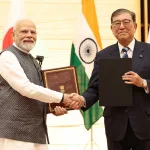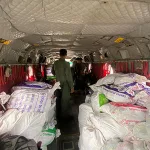BOOK REVIEW
The history of mankind since its earliest recorded versions in as many languages as thinkable has been fraught with internecine conflicts for reasons ranging from an insatiable lust for land, women or hoisting one’s views on others by means that may not be commensurate with a civilized world. Unfortunately even to this day and date the same mentality is being extended by a powerful community or nation on a weaker side throwing international consideration and propriety to dogs. From present day Ukraine and Armenia to Israel –Palestine the year of 2023 is no different from the era of late 1940s or early 1950s when the Chinese Juggernaut steamrolled into the so called ‘Roof of the world’ (Tibet) crushing in one go one of the most peaceful loving people inhabiting this planet of ours.
This 75 year old struggle of Tibetans against the People’s Republic of China seems to have been stymied by an evil combinationresulting of ‘iron curtaining’ of information emanating from that hapless region as also a systematic sinicization by the CCP (Chinese communist party). Be that as it may, a plethora of excellent books written from a firsthand account of happenings have been tumbling out of this iron curtain to afford a peep into one of the most highly surveillance-hit occupied territories of the world i.e. Tibet. The latest book to join this bandwagon of expose on Tibet is ‘Echoes from forgotten mountains: Tibet in war and peace’ penned by none other than the irresistible Tibetan resistance fighter cum author of repute and an independence activist ‘Jamyang Norbu’. A Kalimpongborn Tibetan having joined the resistance movement in the 1970s who has been highly critical of meekness of the Exile government towards Chinese high handedness since long , despite fickle American support combined with a world of indifference; Jamyang Norbu is a ‘one man army’ out to tear into the Chinese perfidy with all his might at his command.
Though in the past, dime a dozen books of repute on Tibetan affairs have hit the reader’s stands, but nothing comes closer even by a whisker to this book when told with such power and insight that can only ride on the shoulders of an excellent writer like Jamyang Norbu. Ever since he began writing historical plays for the ‘Tibetan institute of performing arts’ in the 1970s, Norbu realized that to document Tibetan history and culture was to resist against its erasure. Over the years he became one of the sharpest chroniclers of his people .doggedly tracking archival material and persuading Tibetans to tell their stories.
This masterpiece of book is neatly divided into 40 chapters with some of the titles taking a reader on to a roller coaster ride itself of Tibetan struggle from its very inception stage– ‘The ghosts of Chamdo, Seventeen point swindle, Requiem,Nest of spies, March winds , A crane from Lithang, wind and wildfire ,The man whose luck dried up, The golden throne or Four rivers six ranges to name a few. Norbu’s book is a detailed and accurate record of the Tibetan resistance against communist china from the first few months of 1950, when Tibet was invaded by communist china. The intrepid writer that Norbu is ,takes a reader on a journey that is lost in time and space ,conjuring up the lush green forests of Markham, Lhasa’s bustling Banakshneighbourhood, the meadows of Lithang, the besieged fortress of Tsethang, the mountain hold out of Mustang in northern Nepal etc. In these places, countless Tibetans rich and poor, monks and lay people, devout Buddhists, and devoted skeptics, oracles and intellectuals, men, women, children and the elderly, aristocrats and commoners, Lhasa urbanites and steppe nomads lived ,fought ,died and hoped.
Norbu tells a reader of ‘Yunru Pun’, the unassuming tribal chief who led the 1955 Lithang uprising that were the first embers in a rebellion which would reverberate the entire eastern Tibet before spreading its arch of fire towards Lhasa; of Phagpa ,the lord Chamberlain who Norbu suspects masterminded the great escape of Dalai Lama from Lhasa in 1959;of ChushiGangdruk’s death –defying ‘Long ride north’ through the desolate Changtang plateau, the PLA hot on their heels, a mirror image of Mao’s long march ; of Trinlay ,the nun who thrown out of her monastery by the ‘Red guards’ became ‘Nyemo Achi’ the leader of the rebel army of the Gods as Tibet buckled under the cultural revolution.
A discerning reader will find to his delight that this seminal book in particular embellishes two main protagonists who are the main anvils around which this entire narrative of Tibetan struggle weaves its web. First personality to cast his mesmerizing effect on the readers is ‘Bhusang, the man whose luck dried up’ and Norbu himself. The first born into a peasant family chafing under aristocratic overlords; the second, to one such aristocratic clan but forced into semi-exile in India long before Chinese annexation. ‘Bhusang’ a rookie doctor in Lhasa when it rebelled against china in 1959 joined the CIA-trained operatives sent to Tibet to help the resistance.
India –raised Norbu was witness to these echoes of doomed struggles, opting to join what remained of it in northern Nepal before going to France to see if Paris’s support of Tibet would be more tangible than Washington’s. Both men saw their dreams turn to dust. Captured by the PLA, Bhusang spent years in Chinese jails, labour camps finding upon release that his wife had remarried and his children had starved to death. He left the country he had fought for, and where nothing was left for him to further dream on. Norbu after resistance’s demise turned to writing and activism. Such were the vicissitudes of life that were the hallmark of the numerous Tibetan resistance fighters that are recreated in all their complexity, richness and defiance which a reader would find this book unstoppable once he leaves through its various pages.
Tibet has been in the news recently, which is significant because on 23 August 2023 Beijing released the 2023 edition of the ‘Standard map of china’ which included Taiwan, the South China Sea, Arunachal Pradesh and the Aksai chin as Chinese territories. A few days later Xinhua news agency reported that president Xi Jinping in a letter addressed to 2023 ‘Forum on the development of Xizang’ had validated the change of name of India’s northern neighbor from Tibet to Xizang. The forum itself was called: ‘new era, New Xizang, New journey: New chapter in Xizang’s high quality development and human rights protection.The ultimate culmination of a long travel of sinicization of Tibet.
With India too locking horns with its bête noire in the high plateau of Tibet and the Galwan clash too fresh in the psyche of the country, this masterpiece of book on Tibet couldn’t have come at a better time. In these circumstances, the publication of ‘Echoes from forgotten mountains—Tibet in war and peace’ is reminding us of about what exactly happened to Tibet in the bygone era and still continuing too in all its ferocity.
A little about the author and the publishers. The author as stated above is an acclaimed Tibetan resistance fighter cum thinker cum activist. He though having been denounced by the Chinese as well as the exile government at HP, the Tibetans read his books with equal relish and aplomb. The Beijing based Tibetan poet and blogger Tsering Woesar’ has described him as the ‘Lu Xun‘ of Tibet. Published by Penguin random house India pvt limited with ISBN code as 0670094668 and 9780670094660 the book has in all 962 pages that makes a heavy reading for a reader. With an excellent background of snowcapped peaks of Tibet and Khampa fighters with all their weaponry, the front cover of the book is a fascinating and alluring USP of this book. Priced at Rs 1,299 only, the book is within the purchasing realm of a discerning reader.
(The writer is a retired army officer and can be approached on his email…[email protected])





